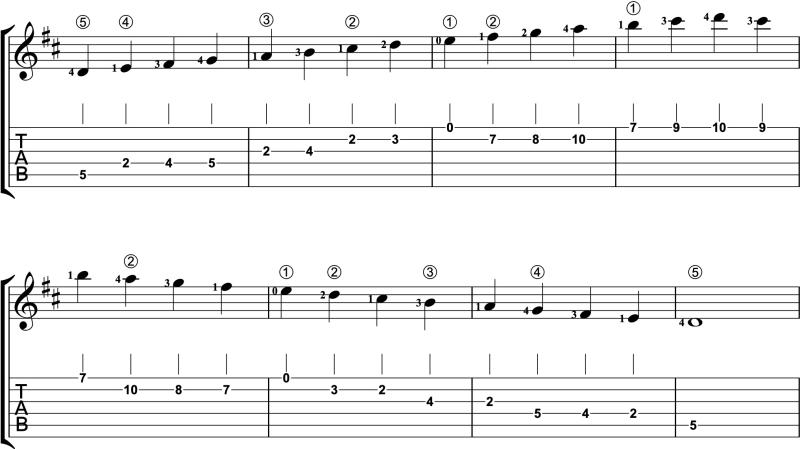Learn to Play an D Major Scale on Guitar
Let’s learn together how to play a D Major scale on guitar.
D Major Guitar Scale Notes
The notes of the D Major guitar scale are the following:
D-E-F#-G-A-B-C#-D
Key Signature
D Major has two sharps, F and C. The key signature helps remind us which notes to make sharp to keep the score easier to read.
One-Octave Scales
We’ll be playing the first scale in first position using the “one-finger-per-fret” rule for this scale. All that means is you will assign each left-hand finger to first four frets. So your 1 plays notes on the first fret, 2 on the second, 3 on the third, and 4 on the fourth. While it may feel easier and more comfortable to play this scale with a different fingering, if you’re just starting out stick with this rule. We start out with an open fourth-string D and then we continue with 2 and 4 on the notes E and F#. So when you play the open fourth string, prepare your 2 and 4 over the fourth string so they’re ready. Just let them hover in a row over the string.
You may find that the 2 and 3 make a difficult stretch on the C# and D on the second string. So be sure to place your 2 finger snug up against the fretwire to give your 3 a bit more space.
First Position

Second Position
Next, we’ll play the same scale, but this time in second position. (If “positions” are new to you, go here to learn more about playing in positions.) For now we can still use the “one-finger-per-fret” rule, but now we assign our fingers to new frets. The 1 now plays on the second fret, 2 on the third, 3 on the fourth, and 4 on the fifth. And this time we’ll play all fretted notes, no open strings.

If you find the stretch between notes to be difficult to reach with this scale, you might try using a capo at a higher position first.
D Major Scale Two Octaves
The two-octave scale is almost exactly like the second-position scale we just looked at, but now with a shift up to seventh position to finish the scale. Shifting from one position to another on guitar can interrupt legato, or the smooth connection between notes. This scale uses the open first string to shift. This is a great solution so we don’t detach the note just before the shift and we maintain legato.

D Major Scale Three Octaves
The final D Major scale spans three octaves and requires us to tune our sixth string down to D. Go here for tips on tuning to Drop D. Before you go off to play the whole scale, spend some time getting used to the notes on the sixth string. Drop-D tuning will mean each note on the sixth string is now two frets higher than it was before!
Also pay close attention to the dashes in front of some notes. Those do not mean you should slide like a glissando. Instead, those are guide finger lines.

D Major Scale in Classical Guitar Repertoire
D Major is a favorite key on the guitar and so it appears in so much wonderful music in the repertoire.
Here are some examples of D Major in the classical guitar repertoire.
Rujero by Gaspar Sanz
Julia Florida by Agustín Barrios
Canarios by Gaspar Sanz
Estudio No.3, Op.31 by Fernando Sor

Leave A Comment